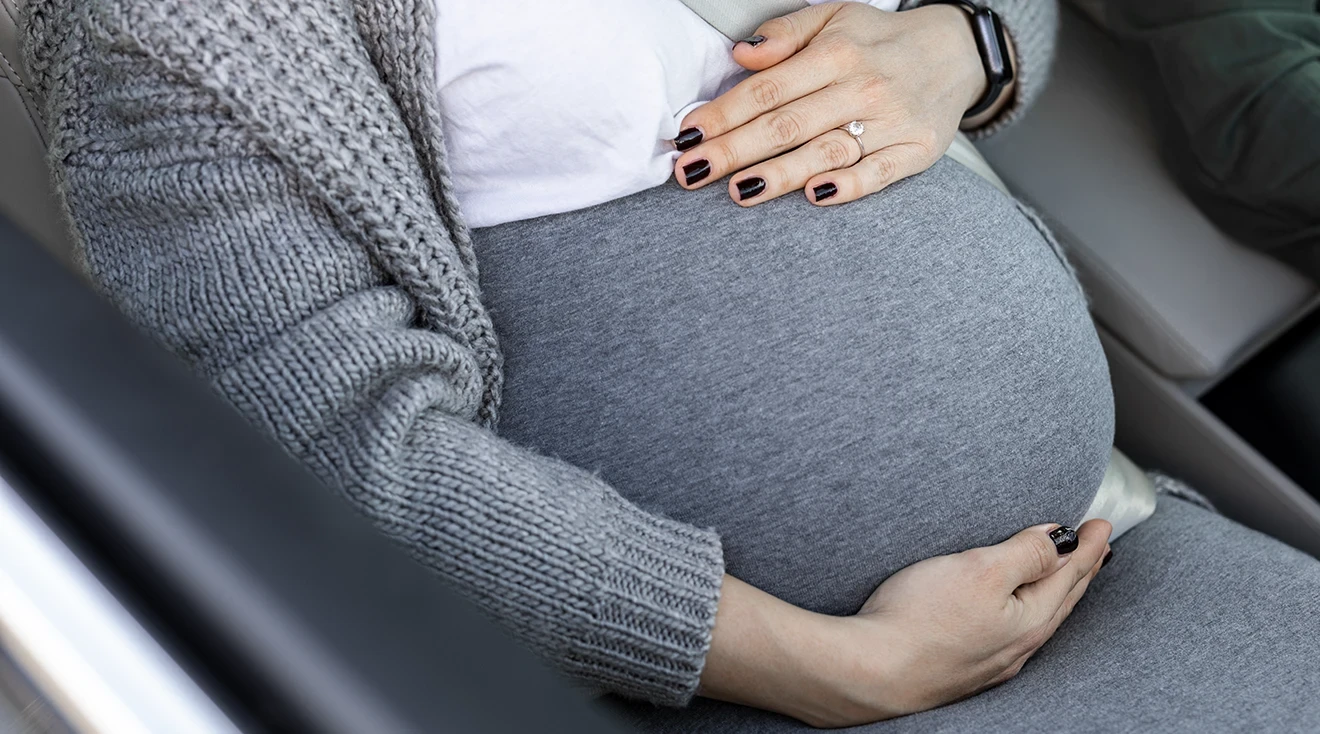What Is Precipitous Labor? (and What to Do if It Begins)
You’ve probably heard stories about someone giving birth on their closet floor or in their car on the way to the hospital. It goes something like this: Contractions came on fast and furious, and before they knew it, baby made a sudden and dramatic debut. It sounds like a scene out of a movie, but what are the odds of actually experiencing precipitous labor (aka a really speedy one)? While it’s not the most routine turn of events, it’s actually more common than you may think. And while you can’t do much to stop it, there are some risk factors and symptoms to be aware of. So exactly what constitutes precipitous labor—and what should you do if delivery is imminent? Read on for the full lowdown.
In layman terms, precipitous labor—also referred to as rapid labor—is one that starts and progresses very quickly. Medically, it’s considered precipitous labor if baby is born within three hours of contractions starting. “It happens in about 3 percent of all births,” says Jian Jenny Tang, MD, an assistant professor of obstetrics, gynecology and reproductive science at the Icahn School of Medicine at Mount Sinai in New York. To put that in perspective,a typical labor—from start to finish—a typical labor lasts approximately 6 to 18 hours, according to the American Pregnancy Association.
The reassuring news? If labor comes on rapidly, it doesn’t necessarily mean you’ll give birth in the back of a taxi or on the side of a road. But it does mean you may deliver sooner than anticipated—and you’ll want to take action fast.
The exact cause of precipitous labor is unknown, says Tang. The reality is, some people will have a long and drawn out labor, and others will have an abbreviated experience. Still, there may be a few risk factors that tip the scale and make a precipitous birth more likely. These include:
- Anatomical predisposition. “Precipitous labors mostly occur when there’s less resistance of the birth canal,” explains Alexander Lin, MD, an ob-gyn at Northwestern Medicine Palos Hospital in Illinois. For example, a birthing person’s cervix could be soft and may dilate more easily. A wide pelvis may also more readily facilitate an efficient labor and delivery.
- Baby’s size. A smaller baby may lend itself to a precipitous delivery, notes Tang.
- Placental abruption. If the placenta separates from the wall of the uterus, a precipitous delivery may occur, says Sarah Gutman, MD, an ob-gyn and assistant professor of clinical obstetrics and gynecology at Penn Medicine in Philadelphia.
- Blood pressure. High blood pressure or preeclampsia puts you at greater risk for experiencing precipitous labor.
- Your birth history. Subsequent pregnancies tend to have speedier deliveries. To this point, Lin says that precipitous birth is more common among people who’ve had a previous vaginal delivery. Of course, those who have a prior history of precipitous labor are even more at risk.
While you can have a precipitous labor and delivery without issue, there are a few potential complications and concerns, including:
- Tearing. Things happen fast in a precipitous labor. You may be more likely to experience vaginal tears and lacerations due to the tissue not stretching out of the way during delivery, says Kirsten Phillips, MD, an ob-gyn at Corewell Health in Grand Rapids, Michigan.
- Heavy bleeding. Precipitous labor puts you at higher risk for a postpartum hemorrhage (or heavy bleeding). Phillips notes that this happens when the uterus doesn’t contract back down after delivery.
- Risks to baby. Baby is at an increased risk for breathing in meconium during a precipitous birth. Moreover, they may be more likely to face an injury, such as shoulder dystocia, notes Lin.
- Retained placenta. There may be increased difficulty delivering the placenta after a precipitous birth.
- Lack of pain management. Someone who experiences precipitous labor is more likely to deliver outside of a labor and delivery setting. “This means they may not get their preferred plan for pain management during delivery,” says Gutman.
- Subsequent preterm birth. A study found that 7.3 percent of people who previously experienced precipitous labor had preterm births in subsequent pregnancies. (This is compared to 2.6 percent of people who had average length labors in prior pregnancies.)
- Anxiety about future deliveries. Phillips says that she often sees patients who have had precipitous labor in the past worry about subsequent experiences. “Precipitous delivery can be psychologically traumatic for patients,” she adds. This is why it’s so important to of discuss your medical history and your feelings and fears with your doctor.
It can be difficult to discern the symptoms of precipitous labor from a typical labor that moves at a more steady, predictable pace. “Oftentimes there aren’t any /[different symptoms] until advanced cervical dilation or delivery is imminent,” says Phillips. However, there are some warning signs you can look for. For starters, having abnormally strong uterine contractions from the get go with little to no break in between can be an initial tip off, says Phillips. Here are a few symptoms to be aware of:
- An urge to push soon after contractions start
- Intense contractions with very short breaks in between
- Vaginal bleeding
Phillips reiterates that some people experiencing precipitous labor won’t even realize it, as they may not feel major pain until just before delivery. But, in general, if you realize your contractions are increasing in frequency and intensity quickly, it’s time to call your doctor.
More likely than not, you’ll experience a labor that progresses at a normal pace. Still, precipitous labors do occur, so it never hurts to be prepared.
If you suspect you’re experiencing precipitous labor, Phillips recommends that you get to the nearest hospital as quickly as you can—preferably one with a labor and delivery unit, since “unfortunately, there’s no way to stop true labor once it starts or slow it down,” says Philips.
That said, Gutman emphasizes that you shouldn’t attempt to drive or walk by yourself. If you don’t think you have enough time to make it to the hospital, or you’re alone, call 911 and alert your doctor. They should be able to walk you through the next steps while you wait for medical help to arrive.
You can’t really prevent precipitous labor and delivery. Baby will come when baby is ready, and the unknown is what makes this situation feel so scary. That said, keeping up with your regular prenatal care appointments is one important way to stay on top of your pregnancy’s progression. Your doctor will check your blood pressure and start doing routine dilation checks, says Tang. And if they find any red flags that could point to an increased risk of precipitous labor, they’ll let you know.
If you’ve experienced precipitous labor in the past—or you’re at known risk for a rapid birth—there are proactive steps that can be taken to help make delivery safer and more controlled:
- Consider an induction. Gutman recommends talking to your doctor about the pros and cons of a medical induction. The main benefit is that it can ensure you’re in the right setting (like a hospital) when labor starts. Of course, that’s assuming you make it to your induction date, which, ideally, should be no earlier than the 39-week mark, advises Tang.
- Regular dilation checks. If you have a history of precipitous delivery, ask your doctor to start checking your cervix for dilation around 36 weeks (although some doctors may recommend waiting till 37 weeks, as cervical checks can sometimes increase risk of preterm labor and infections). Lin says that if you’ve progressed more than expected, it may provide a heads up that a precipitous delivery could occur.
There’s not much you can do, but having a plan in place will help. Getting your ducks in a row in advance sets the stage for a less stressful situation, should rapid labor strike. Keep your phone charged and pack your hospital bag early (and maybe even stash it in the car). The goal is a safe and happy delivery. Knowing what to anticipate can help you recognize the signs of precipitous delivery and empower you to take swift action.
Please note: The Bump and the materials and information it contains are not intended to, and do not constitute, medical or other health advice or diagnosis and should not be used as such. You should always consult with a qualified physician or health professional about your specific circumstances.
Plus, more from The Bump:
Sarah Gutman, MD, MSPH, is an ob-gyn and complex family planning specialist. She also serves as an assistant professor of clinical obstetrics and gynecology at Penn Medicine in Philadelphia. She received her medical degree from Hofstra University in New York.
Alexander Lin, MD, is an ob-gyn at Northwestern Medicine Palos Hospital in Illinois. He received his medical degree from the University of Michigan.
Kirsten Phillips, MD, is an ob-gyn with SHMG Obstetrics and Gynecology in Grand Rapids, Michigan. She earned her medical degree from the University of Toledo in Ohio.
Jian Jenny Tang, MD, is an ob-gyn and assistant professor of obstetrics, gynecology and reproductive science at the Icahn School of Medicine at Mount Sinai in New York. She received her medical degree from the University of Wisconsin.
American Pregnancy Association, Rapid Labor, 2023
Obstetrics & Gynecology, Impact of a Rapid Second Stage of Labor on Subsequent Pregnancy Outcomes, May 2016
Learn how we ensure the accuracy of our content through our editorial and medical review process.
Navigate forward to interact with the calendar and select a date. Press the question mark key to get the keyboard shortcuts for changing dates.




















































